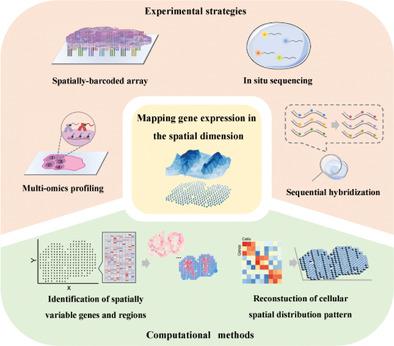当前位置:
X-MOL 学术
›
Small Methods
›
论文详情
Our official English website, www.x-mol.net, welcomes your
feedback! (Note: you will need to create a separate account there.)
Mapping Gene Expression in the Spatial Dimension
Small Methods ( IF 10.7 ) Pub Date : 2021-09-17 , DOI: 10.1002/smtd.202100722 Yingwen Chen 1 , Weizhou Qian 1 , Li Lin 1 , Linfeng Cai 1 , Kun Yin 1 , Shaowei Jiang 1 , Jia Song 2 , Ray P S Han 3 , Chaoyong Yang 1, 2
Small Methods ( IF 10.7 ) Pub Date : 2021-09-17 , DOI: 10.1002/smtd.202100722 Yingwen Chen 1 , Weizhou Qian 1 , Li Lin 1 , Linfeng Cai 1 , Kun Yin 1 , Shaowei Jiang 1 , Jia Song 2 , Ray P S Han 3 , Chaoyong Yang 1, 2
Affiliation

|
The main function and biological processes of tissues are determined by the combination of gene expression and spatial organization of their cells. RNA sequencing technologies have primarily interrogated gene expression without preserving the native spatial context of cells. However, the emergence of various spatially-resolved transcriptome analysis methods now makes it possible to map the gene expression to specific coordinates within tissues, enabling transcriptional heterogeneity between different regions, and for the localization of specific transcripts and novel spatial markers to be revealed. Hence, spatially-resolved transcriptome analysis technologies have broad utility in research into human disease and developmental biology. Here, recent advances in spatially-resolved transcriptome analysis methods are summarized, including experimental technologies and computational methods. Strengths, challenges, and potential applications of those methods are highlighted, and perspectives in this field are provided.
中文翻译:

在空间维度映射基因表达
组织的主要功能和生物学过程是由其细胞的基因表达和空间组织共同决定的。RNA 测序技术主要在不保留细胞的天然空间背景的情况下询问基因表达。然而,各种空间分辨转录组分析方法的出现使得将基因表达映射到组织内的特定坐标成为可能,从而实现不同区域之间的转录异质性,并揭示特定转录物的定位和新的空间标记。因此,空间分辨的转录组分析技术在人类疾病和发育生物学研究中具有广泛的用途。在这里,总结了空间分辨转录组分析方法的最新进展,包括实验技术和计算方法。强调了这些方法的优势、挑战和潜在应用,并提供了该领域的观点。
更新日期:2021-11-12
中文翻译:

在空间维度映射基因表达
组织的主要功能和生物学过程是由其细胞的基因表达和空间组织共同决定的。RNA 测序技术主要在不保留细胞的天然空间背景的情况下询问基因表达。然而,各种空间分辨转录组分析方法的出现使得将基因表达映射到组织内的特定坐标成为可能,从而实现不同区域之间的转录异质性,并揭示特定转录物的定位和新的空间标记。因此,空间分辨的转录组分析技术在人类疾病和发育生物学研究中具有广泛的用途。在这里,总结了空间分辨转录组分析方法的最新进展,包括实验技术和计算方法。强调了这些方法的优势、挑战和潜在应用,并提供了该领域的观点。











































 京公网安备 11010802027423号
京公网安备 11010802027423号